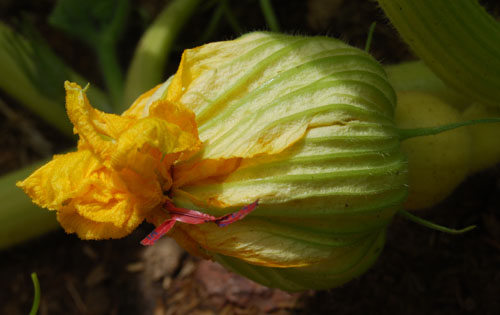Another gardener friend, Mac asked me a great question about the female flower and the timing of the pollination so I thought I’d give you all some more info.
When you spot a female pumpkin blossom that you want to hand pollinate later, you need to watch it daily as it grows. The optimal position of a female flower will be on the main vine and at least 10 feet out or longer although I did pollinate one this year at 8 feet out for insurance in case no others ‘took’. I will also pollinate every female flower on the secondary vines that grow out from the main vine on the sides. This is all for insurance in case something happens to the best one. Later, after I feel confident which one of these pumpkins is growing the fastest, I will cull all but the first and second fastest growers. So each plant I care about, will have 2 giant pumpkins growing on them. The first and a backup.
Here is a female blossom NOT READY. The blossom is still very green although getting larger.
Here is a female blossom that will be ready to open the next morning. So how do I know when the female blossom will open? I watch the female blossoms closely (they are the ones with the baby pumpkin attached to the base of the flower. I always look for the blossom to get big (still closed) and then the day before, the blossom will get the slightest hint of yellow green on the tip. That’s when I know it will open the next morning. Works everytime. I cover the female flower the night before after the color change and get out in the patch early the next morning.
We have 4 hours from the time the blossom opens which is always first thing in the morning. This is usually between 6am -10am. So I cover the female flower the night before with a piece of row cover and get out in the patch early before the beez take all the pollen from the male flowers. Many times I cover three male flowers that will be ready the next day as well (they haven’t opened up but look like they will the next day) so I have lots of pollen on them. The beez get out early too and will take it all of their pollen if not covered. The pollen is food for the bees. It is protein for them. Beez will go after the nectar and the pollen on these plants. I’m sure the beez are attracted to the big blossoms and wonderfully sweet smell the blossoms emit. Someone should make a perfume out of this smell-it is wonderful. What would that be? Parfum de fleurs de citrouille (scent of pumpkin flowers)!! If I know I’m pollinating, I will get up early. Generally between 6-8 am is when I pollinate them but I have forgotten sometimes and ran out at 10 am to pollinate.
Then after pollination be sure to close up the female with a twistie tie or piece of string for 24 hours as shown here. After 24 hours, you can let the flower open up cause it will either be successful or not and you won’t know till after at least day 10 (that is the benchmark) if it was successful. The female flower shrivels up and drops off (like an umbilical cord) and the baby pumpkin will get larger and larger. If the pollination didn’t take it could be because of several reasons. One reason is because it was too hot the day of pollination (over 90°F). This might cause some pumpkins to abort later. The second reason is because we didn’t get enough pollen on the stigma part of the female blossom. Either way, you’ll see the pumpkin start to grow and then suddenly stop. It looses it shininess, getting duller and softer and usually spots show up as it decays which is a self abortion. If this happens, cut it off. That is why we pollinate more than we need because sometimes the plant self aborts its babies if something is wrong-kind of like a miscarriage for us.


